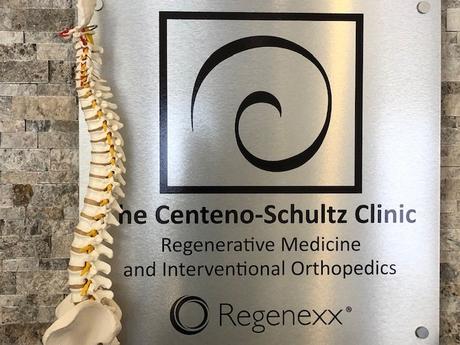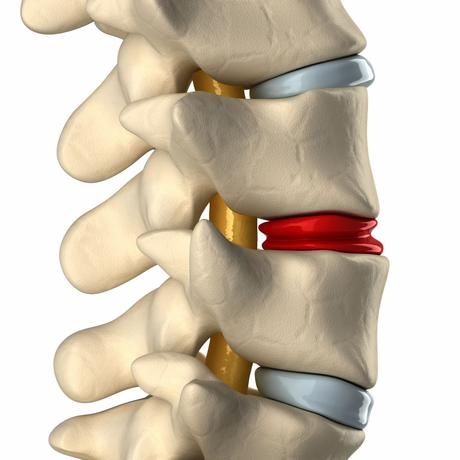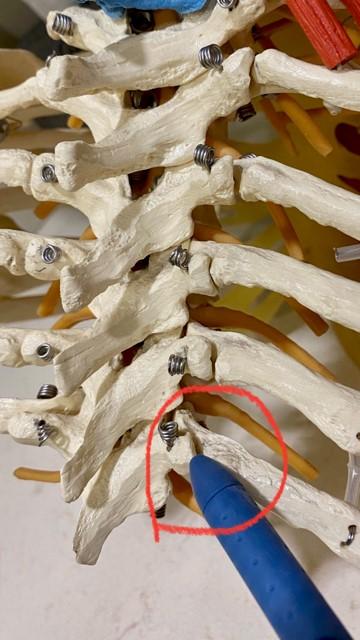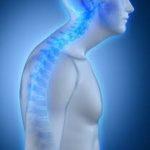It was all a blur. While sitting at a red light, you were rear-ended. The pain was like a lightning bolt between your shoulder blades. Virtually any movement makes it worse. Your doctor thinks you have thoracic spine pain and recommends a referral. What is Thoracic Spine Pain? What is the Thoracic Spine? What are Thoracic Spine Pain Symptoms? What are the most common causes of Thoracic Spine Pain? When is thoracic spine pain a red flag? What are the treatment options for thoracic spine pain? What regenerative treatment options exist for thoracic spine pain? Let’s dig in.
Introduction
Pain can be debilitating and can erode one’s sense of purpose and well-being. Unfortunately, compared to the neck and low back, thoracic spine pain has received little attention. Why?
It is a complex area that has many moving parts which are discussed below. Thoracic injections have potentially significant complications given the close proximity of the nerves, blood vessels, and lungs. A needle that is advanced too deep or too lateral to the targeted thoracic structure can potentially puncture the lung causing a collapse of the lung also known as pneumothorax.
This is the first of many blogs discussing thoracic pain and treatment options. At the Centeno-Schultz Clinic, we are experts in the evaluation and treatment of thoracic pain.
What is Thoracic Spine Pain?
Simply put thoracic spine pain is pain that arises from the thoracic spine. It may be acute or chronic. It may be constant or intermittent. It may be mild or can be so severe as to take your breath away. To better understand thoracic spine pain please review the sections below.
What is the Thoracic Spine? 

The thoracic spine is that part of the spine that is sandwiched between the neck and low back. Many refer to it as the middle section of your spine. It starts at the base of your neck and ends at the bottom of your ribs.
The spine is broken down into three separate and distinct areas:
Cervical Spine: AKA the neck
Lumbar Spine: AKA the low back
Thoracic Spine: The area between the neck and low back that includes the shoulder blades, spine, and ribs.
The thoracic spine is the longest region in the spine. It is compromised of the following structures (1):
Vertebral Bodies: Basically, the boney building blocks of the spine. The vertebral bodies are stacked on top of each other. There are 12 vertebral bodies which are labeled from T1-T12.

Discs: The shocker absorber is sandwiched between each of the boney building blocks. They are identified by the vertebral bodies that they are sandwiched between. For example, the disc between the T5 and T6 building blocks is labeled the T5/6 disc.
Facet Joints: A paired joint that is present at each level of the thoracic spine. There is a right and left facet joint at each level. It is lined with cartilage which allows the two boney surfaces to slide effortlessly. Facet joints provide stability and guide and limit movement of the spinal segment. They are susceptible to injury and can cause significant thoracic spine pain.
Ligaments: A thick band of connective tissue that connects bone to bone. Think of them as the duct tape that holds your bones together.
Tendons: A tough cord-like tissue that attaches muscle to bone.
Blood vessels: A network of arteries and veins that provide oxygen and other nutrients to your body.
Nerves: Critical structures that transmit electrical impulses and other information throughout the body.
Muscles: Provide critical support for the thoracic spine and can be strained or torn from repetitive actions or trauma.
Costovertebral Joints: A small but very important joint formed by the rib head and the transverse process. Like all joints, it is lined with cartilage and surrounded by a thick capsule.

What is Thoracic Spine Pain Symptoms? (Pain, Stiffness, Restriction in Range of Motion, and Muscle Spasm)
The most common symptom associated with thoracic spine pain is pain. The pain can be constant or intermittent with varying intensity. The quality of the pain can be aching and throbbing like a toothache or burning and electrical. It may be confined to a discrete area or may be diffuse and involve the entire thoracic spine.
Thoracic Spine pain can also radiate to:
- Upward into the neck and trapezius
- Downward into the lumbar spine
- Across the chest wall ( the flank)
- Across the chest wall into the front of the chest (sternum)
Other symptoms of thoracic spine pain include:
- Stiffness with restriction in range of motion.
- Muscle spasms
- Inability to maintain normal posture
What are the Most Common Causes of Thoracic Spine Pain?
Thoracic disc herniation: damage to the outer lining of the disc (annulus) with the release of toxic chemicals causing pain.
Thoracic facet injury: This important joint can be injured resulting in pain and restriction in range of motion. The two most common causes include trauma and arthritis.
Costovertebral Joints: Like the facet joint, the costovertebral joint is susceptible to injury resulting in pain and restriction in range of motion.
Ligament instability: Ligaments are the duct tape that provides support to the spine. Injury to the ligaments or congenital damage of the ligaments can lead to thoracic instability. Thoracic instability in turn can result in excessive wear and injury to the thoracic discs, facets, tendons, and costovertebral joints leading to pain.
Referred Pain: Pain perceived in the thoracic region may not be arising from a thoracic structure. Rather it may be referred from a structure that is not in the thoracic spine. Such is the case with cervical facet injuries. Injuries to the C5/6 and C6/7 facet joints refer to the thoracic spine. To learn more about facet injuries and treatment please click here.
Rib Injuries: trauma or fracture of the ribs can lead to thoracic spine pain.
Osteoporosis: At risk for compression fractures.

Kyphosis: A condition in which the thoracic spine becomes hunched forward with excessive forces on the thoracic muscles, tendons, ligaments, discs, and facets.
Scoliosis: An abnormal side-to-side curvature can cause significant thoracic pain.
Infection: bone, facet joint, costovertebral joint, and muscle infections can lead to debilitating thoracic spine pain.
Shingles: a viral infection that can cause a painful rash in the thoracic spine area.
When is Thoracic Spine Pain a Red Flag?
Persistent thoracic spine pain that compromises well-being and function and that has not responded to conservative therapy warrants concern and deeper investigation. The pain is a warning sign that you have an underlying problem that needs evaluation. If left unchecked the damage can increase in severity limiting treatment options and prolonging your return to a meaningful and exciting life.
What are the Treatments Options for Thoracic Spine Pain?
There are a number of treatment options that include:
Physical Therapy: To improve mobility and strength. Modalities include stretching, heat, ice, ultrasound, and trigger point injections (2).
Medications: Nonsteroidal anti-inflammatory agents such as Ibuprofen are commonly prescribed. These medications have significant side effects which have been previously discussed. Oral steroids such as prednisone dose pack are used but are also associated with significant side effects. (insert link). NSAID and steroids do not address the underlying injury but only mask the inflammation and pain at the expense of significant side effects and potential progression of the underlying injury.
Injections: If physical therapy and oral medications fail, some patients are referred for injections. Steroids are typically used in the injections which are potent anti-inflammatory agents with significant side effects and can potentially damage the cartilage in the facet and costovertebral joint (3).
Surgery: This is an uncommon option as the risks of thoracic spine surgery are significant and can include injury to the lung and heart.
What Regenerative Options are available to treat Thoracic Spine Pain?
The Centeno Schultz Clinic are experts in the evaluation and treatment of thoracic pain. We are board-certified, fellowship-trained physicians who are experts in the use of x-ray and ultrasound-guided injections. Treatment options include PRP and bone marrow-derived stem cell injections. All injections are performed under ultrasound and or ultrasound guidance to ensure accurate placement of the PRP and to avoid injury to the lung. Thoracic injections are not a procedure that your PCP or orthopedic surgeon can perform. It takes mastery of anatomy, fluoroscopy, and ultrasound to successfully perform these procedures. To learn more about the significant differences between the Centeno Schultz Clinic and other clinics please click here.
In Summary
Thoracic spine pain is pain that arises from the middle portion of your back. The thoracic spine is sandwiched between the neck and the low back. It contains a number of important structures: Discs, facet joints, ligaments, tendons, blood vessels, nerves, muscles, and costovertebral joints. Thoracic spine symptoms include pain, muscle spasms, stiffness, and restriction in range of motion. The most common causes of thoracic spine pain include disc herniation, facet injury, costovertebral joint injury, ligament instability, rib injuries, referred pain, osteoporosis, kyphosis, scoliosis, infection, and shingles. Traditional treatments for thoracic spine pain include physical therapy, medications, steroid injections, and surgery. Regenerative treatments include the use of PRP and bone marrow concentrate.
At the Centeno-Schultz Clinic, we are experts in the management of thoracic spine pain. If you or a loved one suffers from persistent thoracic pain that has not responded to conservative care please a new patient evaluation. For those not in the Denver Boulder area we offer telemedicine appointments. A board-certified, fellowship-trained physician will compassionately review your history, symptoms, and radiographic studies and discuss possible treatment options. To schedule please contact Jen at 720-287-7196 or [email protected] or Vanessa at [email protected]. It is time to stop suffering and start living life to its fullest.
1.Louw A, Schmidt SG. Chronic pain and the thoracic spine. J Man Manip Ther. 2015 Jul;23(3):162-8. doi: 10.1179/2042618615Y.0000000006. PMID: 26308707; PMCID: PMC4534852.
2.Heneghan NR, Lokhaug SM, Tyros I, Longvastøl S, Rushton A. Clinical reasoning framework for thoracic spine exercise prescription in sport: a systematic review and narrative synthesis. BMJ Open Sport Exerc Med. 2020 Mar 29;6(1):e000713. doi: 10.1136/bmjsem-2019-000713. PMID: 32341799; PMCID: PMC7173996.
3.Wernecke C, Braun HJ, Dragoo JL. The Effect of Intra-articular Corticosteroids on Articular Cartilage: A Systematic Review. Orthop J Sports Med. 2015;3(5):2325967115581163.doi: 10.1177/2325967115581163.

